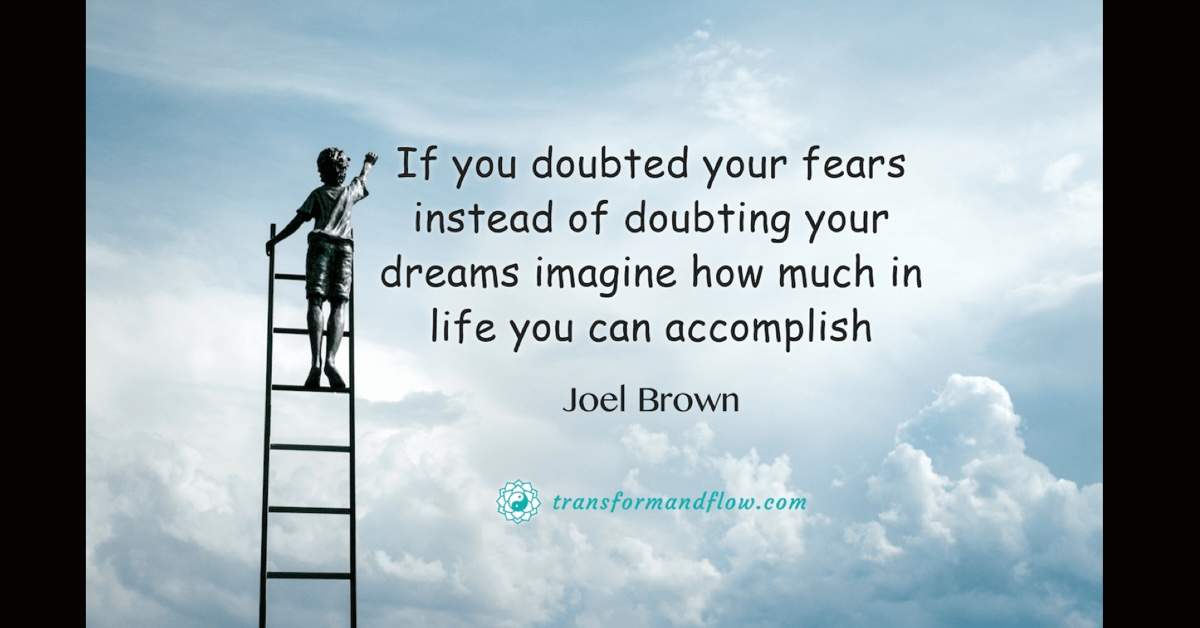Joel Brown’s potent statement,
“If you doubted your fears instead of doubting your dreams, imagine how much in life you could accomplish”
illuminates a fundamental truth about human potential. We often become entangled in a web of self-doubt, allowing our fears to dictate our actions and limit our horizons. Yet, what if we flipped this paradigm? What if we approached our fears with skepticism, questioning their validity, while nurturing our dreams with unwavering belief?
This quote isn’t merely a motivational platitude; it’s a call to reclaim our agency, to dismantle the internal barriers that hold us captive. It’s about recognizing that our fears are often projections, shadows cast by our insecurities, while our dreams are the beacons that illuminate our true potential.
The Neuroscience of Doubt and Belief:
Neuroscience has provided compelling evidence of how our beliefs and fears impact our brains and behaviors. Studies have shown that fear activates the amygdala, the brain’s “fight or flight” center, triggering a cascade of stress hormones that impair cognitive function and hinder our ability to think rationally. Conversely, belief and positive expectations activate the prefrontal cortex, the brain’s executive control center, enhancing focus, creativity, and problem-solving abilities.
When we doubt our dreams, we essentially reinforce neural pathways associated with fear and limitation. This creates a self-fulfilling prophecy, where our doubts become the very obstacles that prevent us from achieving our goals. By consciously shifting our focus to doubting our fears, we can rewire our brains, creating new neural pathways that support belief, resilience, and action.
- Interesting article: Psychology Fanatic – Behavioral Neuroscience: Linking Brain Activity to Human Behavior
Historical Examples of Doubt Defied:
History is replete with individuals who defied the prevailing doubts and fears of their time, achieving extraordinary feats by clinging to their dreams.
These individuals exemplify the power of doubting fears and embracing dreams. They demonstrate that the greatest obstacles we face are often self-imposed, and that with unwavering belief and relentless determination, we can transcend the perceived limitations of our time.
The Wright Brothers:
At the turn of the 20th century, the idea of heavier-than-air flight was met with widespread skepticism and ridicule. Yet, Wilbur and Orville Wright, driven by an unwavering belief in their dream, persevered through countless setbacks and technical challenges. They doubted the limitations imposed by conventional wisdom, and their relentless pursuit of their vision led to the dawn of aviation.
National Air and Space Museum – Creating the First Heavier-Than-Air Powered Aircraft
Marie Curie:
In a time when women were largely excluded from scientific pursuits, Marie Curie dared to dream of unraveling the mysteries of radioactivity. She faced immense prejudice and discrimination, but her unwavering belief in her scientific abilities propelled her forward. She doubted the societal limitations placed upon her gender, and her groundbreaking discoveries revolutionized the field of physics and chemistry.
The Nobel Prize – Marie Curie Biographical
Modalities for Cultivating Belief and Overcoming Fear:
To harness the power of this paradigm shift, we can employ various modalities to cultivate inner resources and dismantle the grip of fear:
- Therapy:
- Therepy helps us identify and challenge negative thought patterns that fuel fear and doubt, while in a safe space with a qualified professional trained in various processes. By reframing our thoughts and adopting perspectives in line with our goals, we can cultivate a more positive and empowering mindset.
- Mindfulness and Meditation:
- Mindfulness practices help us cultivate present-moment awareness, allowing us to observe our fears without being consumed by them. Meditation can help to calm the nervous system, reducing anxiety and promoting a sense of inner peace.
- Visualization and Affirmations:
- Visualizing our dreams and repeating positive affirmations can help to reinforce belief and create a powerful mental image of success. This can help to rewire our brains and create new neural pathways that support our goals.
- Action-Oriented Goal Setting:
- Breaking down large dreams into smaller, actionable steps can help to reduce feelings of overwhelm and build momentum. By focusing on taking consistent action, we can cultivate a sense of progress and reinforce our belief in our ability to achieve our goals.
- The Condition of Self-Compassion: All of the above modalities must be applied with a foundation of self-compassion. If the individual is constantly critical of themselves, and beats themselves up for perceived failures, then all modalities will be less effective. Self compassion creates a safe space to grow.
Conclusion:
Joel Brown’s quote is a powerful reminder that our potential is limited only by the boundaries we impose upon ourselves. By consciously choosing to doubt our fears and embrace our dreams, we can unlock a reservoir of inner strength and resilience that propels us towards our aspirations.
The neuroscience of belief and the historical examples of those who defied doubt underscore the transformative power of this paradigm shift. By employing effective modalities and adding self compassion, we can cultivate the inner resources necessary to navigate life’s challenges and create a future that reflects our highest aspirations.
The journey begins with a simple act of choice: to doubt our fears and believe in our dreams.


